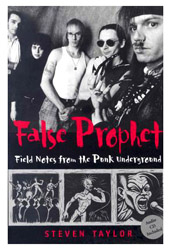| |
 This is, as the author admits, two books in one. The bulk of the volume consists of a memoir of Taylor’s time as guitarist in the punk group False Prophets from 1988-1993, based on extensive extracts from his diaries compiled at the time. This memoir is introduced by the author’s musings on punk history and identity and on his own ethnographic method. Bundled together with a CD featuring several tracks recorded by the band featuring the author, ‘False Prophet’ offers much food for thought.
Steven Taylor certainly has an interesting musical and intellectual pedigree. Occasional musical accompanist to Allen Ginsberg and a member of reformed pre-punks The Fugs since the 1980s, his time in the False Prophets appears to have marked the peak of his musical career. The band had some success in the 1980s and early 90s within the punk scene and were signed for a while (before Taylor’s time) to the seminal punk label Alternative Tentacles. His diary records a period of hectic gig playing and recording including 3 extensive European tours. But by 1993 the band were running out of steam and his slow distancing from the band coincides with his beginning a doctoral programme in ethnomusicology at Brown University (he is now head of the department of writing at Naropa University).
The three quarters of the book that feature his annotated diary of his time in the band (or ‘field notes’ if you prefer) are a fascinating read, sometimes compulsively so. This is one of the best accounts I’ve ever read of the nitty-gritty details of being in a band and in particular of the mechanics of touring and live performance. It is particularly valuable as an account of a band that is not financially successful enough to support its members, yet is too much of a serious commitment to be classed as anything other than ‘professional’. Life for its members was a constant struggle to pay the rent, to juggle other commitments and to keep up the motivation necessary for the band to sustain itself. Being in a band was an exhausting treadmill of intricate interpersonal relationships and negotiations that are times almost hellish (particularly in the case of Taylor’s on-off relationship with the band’s junkie sometime violinist and keyboard player).
It is this near-miracle of persistence that thousands of bands perform all the time, yet has been only intermittently chronicled both in popular music studies and in more journalistic works. Most striking is how the sheer struggle of everyday life as a band member at times overwhelms the actual experience of the music, performing and writing. The moments of near-transcendence and ecstasy are all too few, even if they are crucial to sustain motivation.
Of particular interest are the chapters chronicling the bands’ 3 European tours. Here is a detailed account of the knife-edged economics of touring with its nightmarishly complicated logistics. False Prophets made extensive use of the European squat scene – then at its height – and Taylor offers an unflinching account of the scene’s extraordinary energy and heroism, alongside its occasional idiocies.
If Taylor’s field notes are of great interest, the first ‘book’ of the volume is only worthy of a much more qualified recommendation. A sometimes inspired, sometimes messy, sometimes wayward discussion and appreciation of punk poetics, it is a frustrating read. Taylor focuses on what he calls the ‘punk paradox’, that is the way it provokes ‘identity trouble’ in Judith Butler’s terminology. The paradox is multi-layered and consists of punk’s simultaneous appropriation and negation of the commodity form, its simultaneous negation and affirmation of identity. His claim is that ‘by making a spectacle of the paradoxical nature of identity, punk destabilizes representation and reveals repression’ (22). This is an intriguing argument that is only weakly justified with reference to research of any kind.
Similarly frustrating is Taylor’s narration of punk history. It is heavily weighted towards its American roots and he brings to light punk’s more neglected antecedents of in 50s bohemia, beat poetry and free jazz. But his analysis of punk since the early 80s is conducted in extremely general terms and he ignores almost completely questions of how the punk scene is reproduced and organized and its relationship to other musics.
Taylor argues that this paradoxical subject requires a paradoxical form of writing, that is ‘an ethnography and an essay on ethnography as autobiographical fiction, where the objects of this study/story…are self-contradictory in fact and therefore false’ (11). Yet I don’t believe that this is what Taylor actually achieves. His field notes/diaries are a much more conventional form of writing than is promised. They are only lightly annotated, follow a conventional timeline and hardly destabilize the authorial voice. But it is their conventional format that guarantees their value as a source of anecdote and information on the infrastructures and contexts of punk music-making at the end of the 1980s and the early 1990s. The author may not thank me for saying so, but they constitute a valuable ‘historical document’.
What is disappointing about the book is the near-absolute split between its constituent parts. Taylor’s fieldnotes are the most rewarding element of this book but in the gap between his macro-analysis of the ‘punk paradox’ and his micro-analysis of the everyday struggles of being a punk musician, something crucial gets lost. What is missing is a theorization of how the two link up, how the politics of punk – as a global music scene – ‘got into’ Taylor’s life with the False Prophets. I have always understood this to be the task of ethnography. Whilst I applaud Taylor for making his diaries available to us, ethnography needs to find a better way of moving from the particular to the general. The search for an ethnographic poetics should not supplant the more conventional demands of scholarly rigor.
|
|

